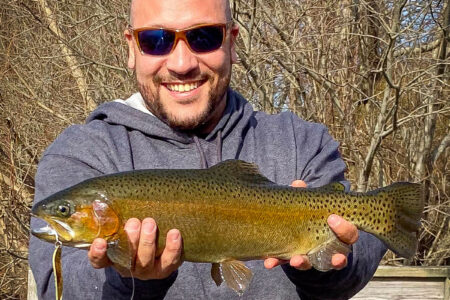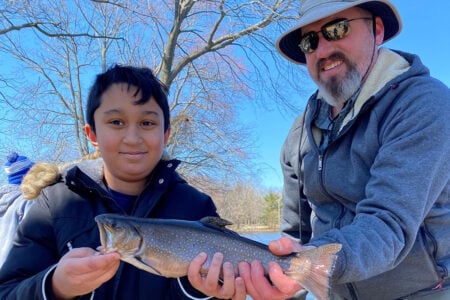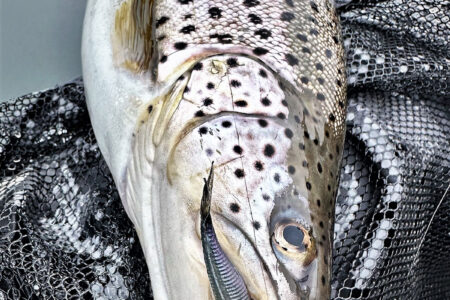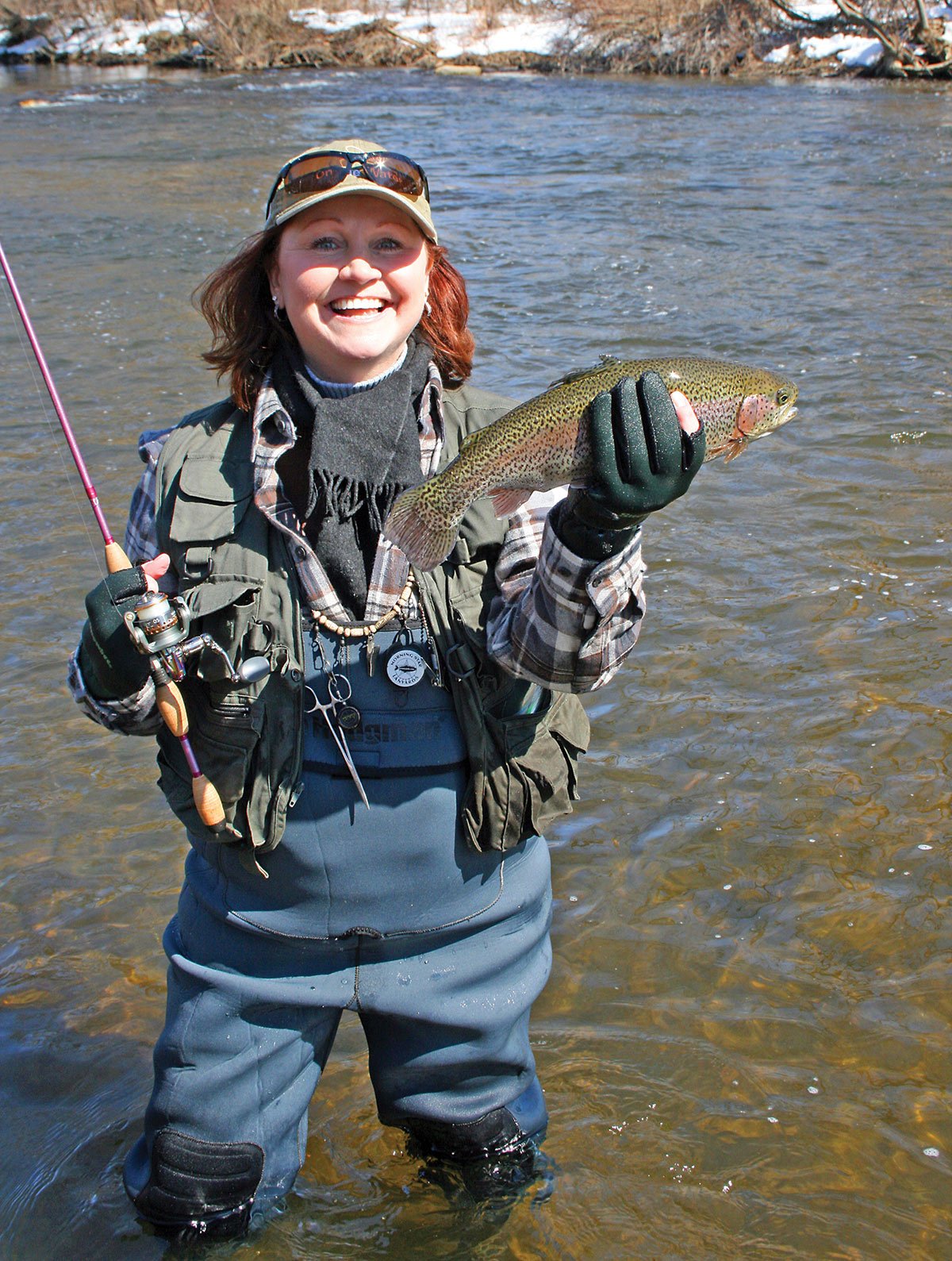
It’s all-systems-go for yet another banner springtime trout stocking throughout the Garden State.
When the 2019 New Jersey trout season officially gets underway on Saturday, April 6 at 8 a.m., 167,530 rainbows will have been released in 170 of the 172 waters statewide that are on the stocking list.
The two venues not dosed for the opener are Round Valley Reservoir in Hunterdon County and Merrill Creek Reservoir in Warren County. These will be injected the first week (April 8-12) of the in-season schedule with 6,480 and 3,520 fish respectively.
As since 2015, and for the foreseeable future, the rainbow trout reigns, and the single species throne continues popular. The Pequest chariot payloads will consist totally of this sassy pink sash-adorned salmonid that is an eager feeder during the cold waters of the early season, strikes hardware and flies with utter abandon, inhales just about any kind of preserved, natural or synthetic baits, fights well on ultra-light tackle and, in suitable habitat, will hold over through the summer swelter.
And with a bit of culinary dexterity – be it over the coals, in a bacon-greased frying pan or in the smoker – the rainbow trout makes a fine repast.
Rainbow Rundown
The standard stockie will average 10-1/2 inches and weigh a half-pound; however, 2% of every pre-season load will be bolstered by spent breeders measuring anywhere from 15 to 23 inches and tipping the scales up to 5-plus pounds. What’s more, during the first two in-season stockings, several thousand additional breeders will be scattered around. All told, it’s expected that 6,000 to 7,000 heavyweights will have been loosed by April 19.
For those interested in high percentage cracks at bruiser ‘bows from the Opening Day 8 o’clock tick of the second hand, the effort should be made to visit any one of the nine swims included in this year’s “Bonus Broodstock” program (see Trout Numbers).
Again this year, 570,000 trout is the baseline figure from the Bureau of Freshwater Fisheries for the spring stocking effort. As in past years, though, it’s a sure bet that the number will prove inaccurate in a very good way: Pequest Hatchery superintendent Ed Conley and his high octane/high enthusiasm crew continue producing thousands upon thousands of surplus trout to stockable size for the spring.
Last year, for example, a whopping 606,961 rainbows were released by the Friday afternoon of the Memorial Day weekend, some 36,961 over baseline. These fish will have put on a bit more length and girth owing to the extended feeding times, as they are not generally added to the respective loads until the fifth week of in-season releases.
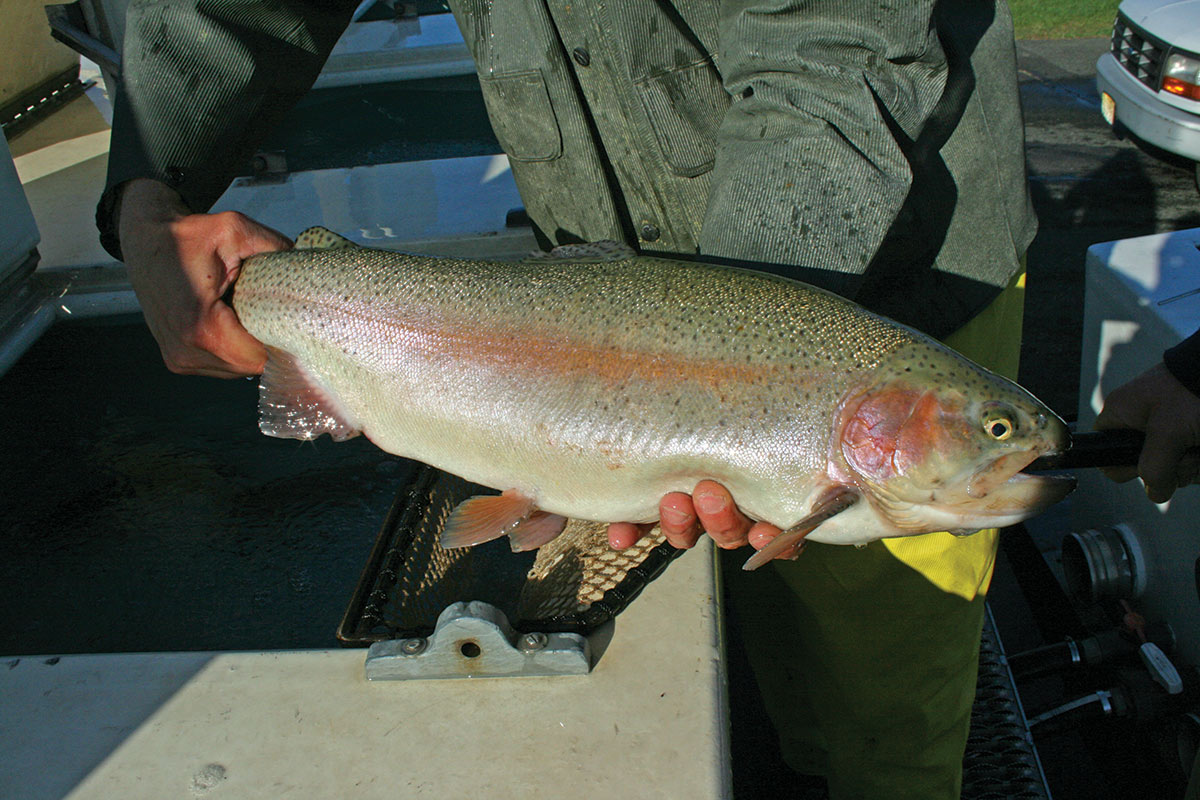
“We know by the end of the third week of the in-season period approximately how many surplus trout we’ll have available,” said Conley, adding “figure a week to make the adjustments to the original numbers for the remaining weeks, so by the fifth week these extra rainbows will start being added to the loads.”
By week five this year, the count of waters still being stocked is 53, then down to 20 in week six, and by week seven (May 20-24) only 16 remain on the roster. If the surplus numbers are anything like last year, that’s a substantial amount of trout flesh larding the already bulky late season loads.
‘Bow Busting Tactics
The monster benefit of stocking rainbows is that they bite in just about any condition save for flood stage waters; and even then, find a pocket of slower water and chances are you can pick off one or two. Although a cold water species, we’ve had rainbows sipping nymphs, gobbling salmon eggs and whacking wacky-rigged Gulp trout worms when the water temps hovered between 71 and 73 degrees.
It’s usually a hyper-cooperative player that strikes myriad baits, hardware and flies with utter abandon. Sure, there are times when they can prove picky, even downright obstinate, despite the best efforts, especially those that have survived a week or two of baits of all kinds, plugs, spoons, spinners, jigs, nymphs and streamers. However, owing to the copious numbers being loosed weekly, there are always fresh recruits to keep the rods bent, and stringers and canvas creels occupied.
“Bright is right” is pretty much the standard for hardware, including plastics, when it comes to getting the attention of stocked rainbows. Pink, chartreuse and orange in particular are the colors that get them cranked, with gold, silver and hybrids such as “firetiger” also attention-grabbers. Be it the body of a spoon or plug, the body or blade of a spinner, the color of the jig head or plastic, these will be the catalysts for follows, interceptions and subsequent strikes.
Ditto jigs. The pink, gold and chartreuse unique Trout Magnet head teamed with a bubblegum, orange, cotton candy, mealworm gold or gold glitter split tail grub is a rainbow wrecker, be it under a float on the drift or on a twitch-stop-twitch retrieve.
Power Bait, in dough, nugget, nibble, egg and cluster, minnow, and insect forms are synonymous with springtime success in both moving and still water environments. Even more so the myriad Gulp baits whose quickly leaching scent will trigger finicky ‘bows to make the commitment when other offerings are generating mediocre results.
Salmon eggs continue standing the test of time and continue proving a devastating bait, both on the drift in a river or stream or under a tiny “egg” bobber in a lake or pond. Again, color can prove critical, with scent another factor. Chartreuse, orange and pink get the nod, with garlic and shrimp scents hands down the double thumbs up when it comes to rainbow reaction. Corn, nightcrawlers and au naturel scented eggs also catch fish, but not to the extent of the herb and crustacean aromas.
Other productive baits include garden and meal worms, wax worms, baby nightcrawlers, kernel corn and in still waters the deadly M&M (meal worm and miniature marshmallow tandem). In this case, sometimes it’s the size of the mealie (standard or giant) and/or the color of the mini mallow (light green, pink or white) that makes the difference between a blow by and a bite.
Trout on the Fly
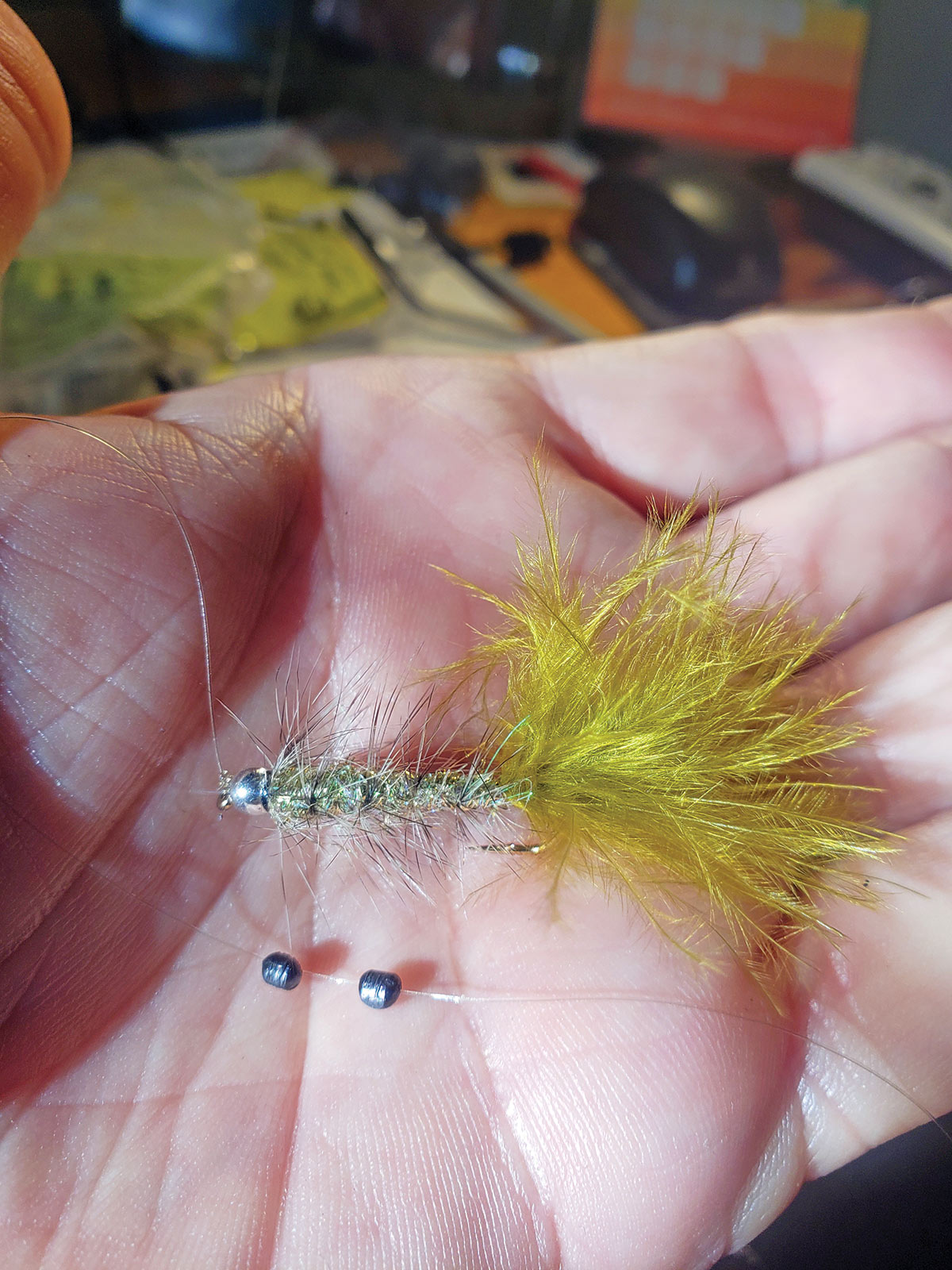
On the long rod end, nymphs – especially the bead headed varieties during the stronger waters prevailing during the first few weeks of the season – get the nod. Drifted properly and patiently with the aid of a “strike indicator” or “sighter” (read: bobber) they will catch trout, and a lot of them. From this corner, though while challenging, it’s too slow a game. As with hardware, streamers make for a more energetic and exciting experience. On wider waters such as the Big Flat Brook below the Route 206 overpass, Musconetcong, Paulins Kill, Ramapo, and Pequest, stripping via the fly rod can generate wrist-tingling takes from rowdy stockies and hair-raising bumps and bangs from the 2-year holdover slab-sides from last year’s October stocking.
On the narrower waters, streamers are heretical players via the ultra-light 5-1/2- to 6-foot spinning rod. Spurred by an A.J. McClane fishing column in Field & Stream way back in the mid-‘60s, complete with a black-and-white photo of a cowboy hat-adorned gent hoisting 20-plus inches of bulging brown trout, a short cut to catching trout with flies was availed. Sure, the sunnies and golden shiners with wets and bushy dries were sure things to a pudgy and bug-eyed-for-trout 9-year-old armed and dangerous with a blue fiberglass Garcia rod, half-rusted Pflueger Medalist reel, a no-name flesh-colored fly line and 5-foot length of 8-pound test Garcia Platyl. However, on the Big Flat adjacent to the long-demolished St. Moritz Inn or on the then long, deep stretch below the Roy Bridge, and again on the South Branch of the Raritan at Ort Farms along Route 513, well, I’m lucky enough to be alive to click this.
The streamer via spinning rod has since caught untold numbers of trout over the decades on swims all over New Jersey. Pretty simple, really – cast quartering and across upstream, same as with a spinner, spoon or plug, and twitch retrieve with short, down-and-to-the-side chops until the fly swings across at the end of the drift. Beadhead streamers are preferred during stronger currents, and sometimes these are aided by a split shot or two. The shot, usually a B or BB is necessary if the pre-weighted streamer is not in the arsenal. Assaults can occur at any time, but it’s usually on the swing where the bang occurs. On a lake or pond, both upward and sideways twitches on the retrieve are strike generators.
In terms of streamer colors, pink, olive, lime, white, purple and black when it comes to the Woolly Bugger. The Mickey Finn, Wild Weasel, Rusty Angel, White Ghost, Olive Matuka and Rooster Matuka, all in sizes #6-10, will cover the crush from parolees to principals.
The daily limit on stocked waters through Memorial Day Monday is six with a minimum length of 9 inches. After, the possession limit drops to four with the same length restriction.
| TROUT NUMBERS |
|---|
|
The long-running Bonus Broodstock Program is designed to ignite interest in New Jersey’s trout fishing opportunities, and its success continues spawning new Trout Stamp buyers. Nine to 10 lakes and ponds spanning the northern, central and southern sectors of the state are dosed with between 30 and 50 spent breeders of 3 years of age, some topping 6 pounds. The breeders are included in the pre-season stocking number in italics (breeder numbers in parenthesis).
Weekly information regarding the 2019 trout stocking can be obtained by calling the 24-hour Trout Stocking Hotline 609-633-6765; scanning the bar code on any “Trout Stocked Water” sign, and also by clicking the trout fishing link at www.njfishandwildlife.com where access information to trout stocked waters is also available. |
